DHW (Domestic hot water) energy consumption is a critical component in multi-family residential building energy modeling. While proper modeling of DHW is essential to creating accurate whole building energy models of multi-family residential buildings, DHW load and energy consumption are extremely difficult to predict, since they are highly influenced by end-user behavior. The existing various calculation methods, including ASHRAE Handbooks, ASHRAE 90.1 User’s Guides, ASPE design Handbooks, local energy codes and LEED guidelines, have been found to result in drastically different DHW load numbers and DHW load profiles, which result in large discrepancies in the analysis of DHW energy consumption. The discrepancies beg the question of which method is most reliable or most accurately represents actual usage in real buildings. In order to gain a better understanding of DHW load and energy calculation in energy simulation, in this study, different standard DHW load calculation methods are performed and compared to actual muti-family residential building meter data with respect to DHW peak demand, load profile, and energy consumption. The factors which impact the energy consumption calculation results are discussed. Recommendations on appropriate calculation methods for DHW energy modeling are made. In addition, the impact of energy conservation measures, such as low flow fixtures and condensing DHW boilers are examined.
Citation: ASHRAE/IBPSA-USA Bldg Simulation Conf, 2016
Product Details
- Published:
- 2016
- Number of Pages:
- 8
- Units of Measure:
- Dual
- File Size:
- 1 file , 2.6 MB
- Product Code(s):
- D-BSC16-19


